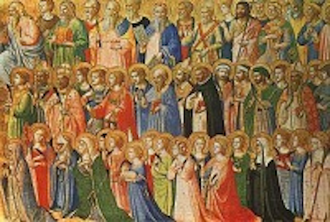All Saints Day

This feast was originally kept in the springtime in the Eastern Church, and dedicated to 'the martyrs of the whole world' as witnessed by John Chrysostom and Ephrem of Syria. In the West, Maximus of Turin preached on the same feast on the same day, the first day of Pentecost.
On 13 May 610, Pope Boniface IV gathered up around 28 wagonloads of bones of martyrs that had been plundered from the catacombs by invaders, and reinterred them beneath the Pantheon in Rome, a pagan temple built by the Emperor Hadrian, which had been dedicated to all the gods. Pope Boniface rededicated this shrine to St Mary and the Martyrs. Many historians see this as the origin of All Saints Day.
Gradually the Church began to recognise other paths to sanctity. The 7th Century lectionary, the Comes of Wurzbourg describes the feast as one of all the saints, not only martyrs.
It is not clear why the Western Church came to celebrate this feast around this date. The Anglo-Saxon theologian Alcuin observed the feast on November 1 in 800, as did his friend Arno, Bishop of Salzburg. The Irish Church also kept this date, according to the manuscripts of Oengus. Rome finally adopted 1 November as All Saints Day in the ninth century.
In the early centuries the only criterion for sainthood was popular acclaim, even when the bishop's approval became the final step in placing a commemoration on the calendar.
The first papal canonisation occurred in 993. The lengthy process now required before someone is beatified and canonised was formalised in the last 500 years.
There are 1,255 ancient churches in England dedicated to All Saints.
Today's feast honours the obscure as well as the famous - those saints each of us have known.
Watch the Litany of the Saints, recorded in the Franciscan Friary in Pantasaph in North Wales: www.youtube.com/watch?v=LI7tHS6zneE












